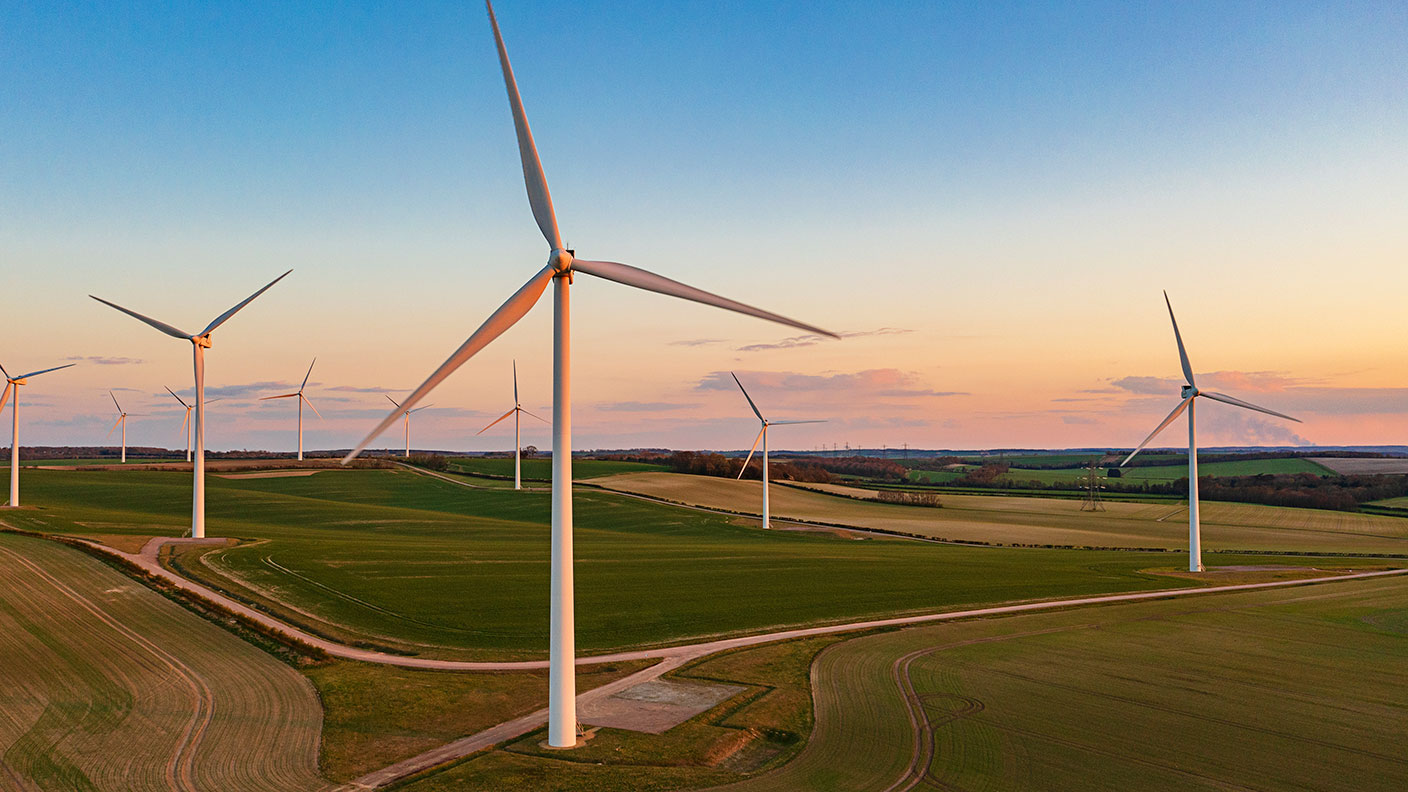The UK’s new energy strategy has been revealed – here’s how you can profit
The UK has just released details of its long-term energy strategy, which emphasises offshore wind power. Rupert Hargreaves explains how you can invest.


Britain’s long-awaited Energy Security Strategy has just been released.
It foresees the country generating around 95% of its electricity from low-carbon sources by 2030. The cornerstone of the plan is a five-fold increase in offshore wind power generation from 10GW to 50GW by the end of the decade.
The UK is already a world leader in wind energy, with more projects in the pipeline than either China or the US. That’s because Britain is uniquely positioned to become a global wind power.
MoneyWeek
Subscribe to MoneyWeek today and get your first six magazine issues absolutely FREE

Sign up to Money Morning
Don't miss the latest investment and personal finances news, market analysis, plus money-saving tips with our free twice-daily newsletter
Don't miss the latest investment and personal finances news, market analysis, plus money-saving tips with our free twice-daily newsletter
The North Sea continental shelf is a geological phenomena, which stretches out for miles from the UK coast, making it far easier and cheaper to install offshore wind turbines than it would be anywhere else in the world.
And thanks to decades of offshore oil production, there’s also a skilled workforce available to help install and maintain turbines and other infrastructure.
So how can you invest?
How to invest in the offshore wind sector
Whatever you think of the practicalities of the government’s new energy strategy, from an investment point of view, it makes sense to follow the money. And when it comes to the key sector in the strategy – offshore wind – institutional investors are queueing up to gain a piece of the action and burnish their green credentials.
For example, Danish multinational Ørsted (CPH: ORSTED), the world's largest developer of offshore wind farms, recently sold a 50% stake in its 1.3 GW Hornsea 2 Offshore Wind Farm (the largest in the world) for £3bn to a consortium including AXA IM Alts and Crédit Agricole. The developer will remain responsible for maintaining the asset once it enters service at the end of the year.
One way to invest in wind farms directly is via Greencoat UK Wind (LSE: UKW). The firm is a “simple, transparent and low risk” way for investors to build exposure to wind farms in the UK.
Its investments generated 2.9GWh of sustainable electricity in 2021, and it continued to build its portfolio, spending £570m on new projects, including three subsidy-free projects last year. Most of this growth was funded by issuing new shares to investors.
At the end of December 2021, the company’s net asset value (NAV) was 133.5p per share and it paid out a dividend of 7.18p per share for the year, giving a yield of 4.6%.
However, my favourite way into the sector is via the UK’s answer to Ørsted, SSE (LSE: SSE). SSE is aiming to build a renewable energy portfolio to generate at least 50TWh by 2030. It is taking advantage of the growing demand for renewable investments to sign up partners for new projects.
With its joint venture partners Marubeni and Copenhagen Infrastructure Partners (CIP), SSE successfully bid for the E1 East site in the ScotWind seabed leasing auction, taking its secured pipeline to around 11GW. The group is also eying up opportunities in North America and Europe.
As well as the company’s attractive growth pipeline, the stock yields 4.5%, although note that the company is planning to reduce this payout in 2024 as it earmarks more cash for growth investments.
How to invest in hydroelectric storage
SSE is working on other renewable energy projects as well as carbon capture technology as part of its “Net Zero Acceleration Programme.” A key, but often overlooked part of the SSE green portfolio is the company’s hydroelectric and pumped storage assets.
Energy from wind and solar assets can be unreliable for obvious reasons, which means we need hydrocarbons to fill the gaps where the sun isn’t shining and the wind isn’t blowing. Nuclear is another stable power source, but chronic underinvestment in Britain's nuclear portfolio means we cannot yet rely on atomic energy to make up the difference.
Hydroelectric and energy storage assets are a ready solution to this problem. Broadly speaking, there are two types of energy storage. Battery energy storage, and pumped storage, which is similar to a hydroelectric plant.
A pumped storage system uses two water reservoirs at different elevations that can generate power as water moves down from one to the other. The system can be switched on to generate electricity relatively quickly if supply from other sources dries up. When the higher reservoir is empty, it is refilled using pumps, but the flexibility of the system means it can be refilled when there’s an excess of cheap, green energy.
Last year SSE Renewables received consent from the Scottish Government to construct the UK’s largest pumped hydro energy storage scheme in the Scottish Highlands. The proposed 1.5GW scheme would more than double the current amount of pumped hydro storage capacity in Great Britain. Its reserves will be enough to power three million homes.
Two ways to invest in battery storage
SSE’s diversification and growth plans put the business in a league of its own. But there are other options available for investors who want to own energy storage assets directly.
The UK's largest utility-scale battery energy storage investment trust is the Gresham House Energy Storage Fund (LSE: GRID). It has 425MW of operational capacity and a market share of 30%. At the end of December, it had a further 717MW of projects due to enter construction, with bigger and better batteries forming the bulk of this pipeline.
At the end 2021, the trust had a cash position of £122m and debt facility of £180m to fund its growth ambitions. It also seems to have the support of investors, having raised £100m in 2021 and £151m via equity fundraisings. Management is expecting to report a NAV per share of 140-145p by 30 June 2020 and pay out a dividend of 7p per share for the year ahead, giving a prospective dividend yield of 4.5%.
The Gore Street Energy Storage Fund (LSE: GSF) is the smaller of the two funds but it claims to be London’s “first listed energy storage fund.” It recently raised £75m from shareholders to pursue 1.3 GW of potential energy storage assets in the UK and internationally, to add to its existing portfolio. Like its peer, Gore Street is also targeting a 7p dividend yield for the year ahead, giving the stock a 6.3% dividend yield.
Get the latest financial news, insights and expert analysis from our award-winning MoneyWeek team, to help you understand what really matters when it comes to your finances.

Rupert is the former deputy digital editor of MoneyWeek. He's an active investor and has always been fascinated by the world of business and investing. His style has been heavily influenced by US investors Warren Buffett and Philip Carret. He is always looking for high-quality growth opportunities trading at a reasonable price, preferring cash generative businesses with strong balance sheets over blue-sky growth stocks.
Rupert has written for many UK and international publications including the Motley Fool, Gurufocus and ValueWalk, aimed at a range of readers; from the first timers to experienced high-net-worth individuals. Rupert has also founded and managed several businesses, including the New York-based hedge fund newsletter, Hidden Value Stocks. He has written over 20 ebooks and appeared as an expert commentator on the BBC World Service.
-
 High earners face £15k income hit by 2029 following Autumn Budget
High earners face £15k income hit by 2029 following Autumn BudgetRachel Reeves’s Autumn Budget means high earners – or HENRYs – are now looking at an income hit running into the thousands. Can you avoid it?
-
 Millions underestimate how many paydays are left until retirement - why you should be counting your payslips
Millions underestimate how many paydays are left until retirement - why you should be counting your payslipsKeeping track of how long you will be earning a salary for can help work out how much you need to put into a workplace pension
-
 What's behind the big shift in Japanese government bonds?
What's behind the big shift in Japanese government bonds?Rising long-term Japanese government bond yields point to growing nervousness about the future – and not just inflation
-
 Halifax: House price slump continues as prices slide for the sixth consecutive month
Halifax: House price slump continues as prices slide for the sixth consecutive monthUK house prices fell again in September as buyers returned, but the slowdown was not as fast as anticipated, latest Halifax data shows. Where are house prices falling the most?
-
 Rents hit a record high - but is the opportunity for buy-to-let investors still strong?
Rents hit a record high - but is the opportunity for buy-to-let investors still strong?UK rent prices have hit a record high with the average hitting over £1,200 a month says Rightmove. Are there still opportunities in buy-to-let?
-
 Pension savers turn to gold investments
Pension savers turn to gold investmentsInvestors are racing to buy gold to protect their pensions from a stock market correction and high inflation, experts say
-
 Where to find the best returns from student accommodation
Where to find the best returns from student accommodationStudent accommodation can be a lucrative investment if you know where to look.
-
 The world’s best bargain stocks
The world’s best bargain stocksSearching for bargain stocks with Alec Cutler of the Orbis Global Balanced Fund, who tells Andrew Van Sickle which sectors are being overlooked.
-
 Revealed: the cheapest cities to own a home in Britain
Revealed: the cheapest cities to own a home in BritainNew research reveals the cheapest cities to own a home, taking account of mortgage payments, utility bills and council tax
-
 UK recession: How to protect your portfolio
UK recession: How to protect your portfolioAs the UK recession is confirmed, we look at ways to protect your wealth.